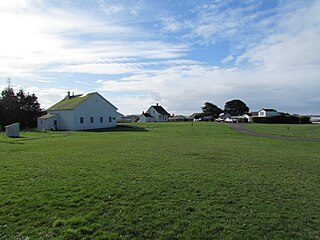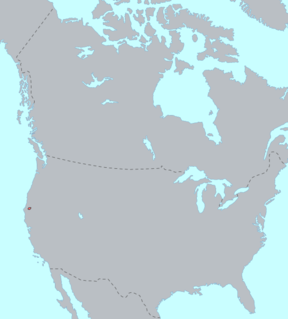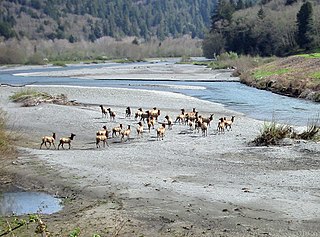
Humboldt County is a county in the U.S. state of California. As of the 2010 census, the population was 132,646. The county seat is Eureka.

The Trinity River is a major river in northwestern California in the United States, and is the principal tributary of the Klamath River. The Trinity flows for 165 miles (266 km) through the Klamath Mountains and Coast Ranges, with a watershed area of nearly 3,000 square miles (7,800 km2) in Trinity and Humboldt Counties. Designated a National Wild and Scenic River, along most of its course the Trinity flows swiftly through tight canyons and mountain meadows.

College of the Redwoods (CR) is a public two-year community college with its main campus in Eureka, California. It is part of the Redwoods Community College District that serves four counties and has two branch campuses, as well as three additional sites. On-campus housing is available at the main campus.

Fort Humboldt State Historic Park is a California state park, located in Eureka, California, United States. Displays interpret the former U.S. Army fort, which was staffed from 1853–1870, the interactions between European Americans and Native Americans in roughly the same period, and both logging equipment and local narrow gauge railroad history of the region. Within the collection, there are trains, logging equipment, including a fully functional Steam Donkey engine, and an authentic Native American dug-out canoe. The Fort overlooks Humboldt Bay from a commanding position atop a bluff. The North Coast regional headquarters of the California State Parks system is located onsite.

The Chimariko are an indigenous people of California, who originally lived in a narrow, 20-mile section of canyon on the Trinity River in Trinity County in northwestern California.

The Whilkut also known as "Redwood Creek Indians" or "Mad River Indians" were an Athapaskan tribe, speaking a dialect similar to the Hupa and Chilula, who inhabited the area on or near the upper Redwood Creek and along the Mad River except near its mouth, up to Iaqua Butte, and some settlement in Grouse Creek in the Trinity River drainage in Northwestern California, before contact with Europeans.
Hoopa Airport is a public airport located on Airport road next to the Trinity river one mile (1.6 km) southeast of Hoopa, serving Humboldt County, California, USA. The airport is mostly used for general aviation.

Hoopa is an unincorporated community and census-designated place (CDP) in Humboldt County, California. It is located 10 miles (16 km) south of Weitchpec, at an elevation of 328 feet (100 m). The ZIP Code is 95546.
Honsading is a former Hupa settlement in Humboldt County, California. It was located on right bank of the Trinity River near Hupa Valley; its precise location is unknown.

Korbel is an unincorporated community in Humboldt County, California. It is located 1.5 miles (2.4 km) east-southeast of Blue Lake, at an elevation of 154 feet. The ZIP Code is 95550.

Fort Gaston was founded on December 4, 1859, in the redwood forests of the Hoopa Valley, in Northern California, on the west bank of the Trinity River, 14 miles (23 km) from where the Trinity flows into the Klamath River. It was located in what is now the Hoopa Valley Indian Reservation. Fort Gaston as part of the Humboldt Military District was intended to control the Hupa Indians and to protect them from hostile white settlers. The post was named for 2nd Lieutenant William Gaston, of the First Dragoons, who had been killed May 17, 1858, during the Spokane–Coeur d'Alene–Paloos War.
The Tsnungwe are a Native American people settled along the Trinity River, South Fork of the Trinity River and New River, in Trinity and Humboldt County in California.

Bald Hills War (1858–1864) was a war fought by the forces of the California Militia, California Volunteers and soldiers of the U. S. Army against the Chilula, Lassik, Hupa, Mattole, Nongatl, Sinkyone, Tsnungwe, Wailaki, Whilkut and Wiyot Native American peoples.
Hoopa Valley is a valley on the lower course of the Trinity River between the confluence of South Fork Trinity River and the Klamath River. The valley opens up above the confluence of Campbell Creek with the Trinity River and extends northward until it closes up again at the foot of Bald Hill. The valley is encompassed by the Hoopa Valley Indian Reservation.
Verdena Leona Parker is the last fluent speaker of the Hupa language, an Athabaskan language spoken by the Hoopa Valley Tribe, indigenous to northern California. While other children of her generation were sent to boarding schools, isolating them from their families, Parker was raised by her grandmother, who spoke Hupa with her. Through adulthood, Parker continued to speak Hupa with her mother daily, maintaining a high level of fluency despite language loss in the rest of the Hupa community.
Victor Golla is a linguist and a leading expert on the indigenous languages of California and Oregon, especially the Pacific Coast Athabaskan subgroup of the Athabaskan language family and the languages of the region that belong to the Penutian phylum. He is emeritus professor of anthropology at Humboldt State University and lives in Trinidad, California.

Pokémon the Movie: Hoopa and the Clash of Ages, known in Japan as Pokémon the Movie XY: The Archdjinni of the Rings: Hoopa is a 2015 Japanese anime adventure film and the 18th in the Pokémon film series created by Satoshi Tajiri. It was directed by Kunihiko Yuyama, written by Atsuhiro Tomioka and produced by OLM. The film stars the voices of Rica Matsumoto, Ikue Ōtani, Mayuki Makiguchi, Yūki Kaji, Mariya Ise, Megumi Hayashibara, Shin-ichiro Miki, Inuko Inuyama, Rie Kugimiya, Kōichi Yamadera, and Shoko Nakagawa. In the film, Hoopa, a Pokémon able to summon people and other Pokémon, splits into two forms: the real Hoopa, and a shadow created after Hoopa's powers were sealed for 100 years. Hoopa's shadow attempts to control the form of the real Hoopa.











